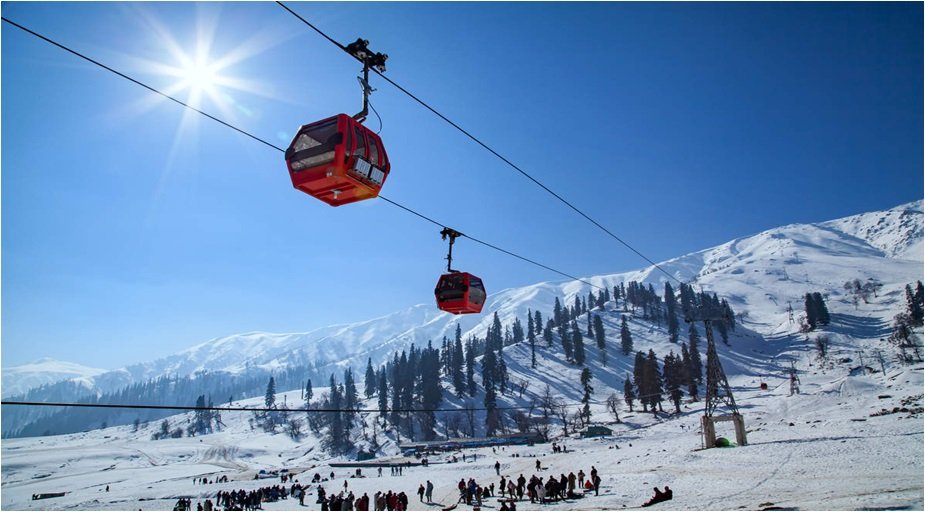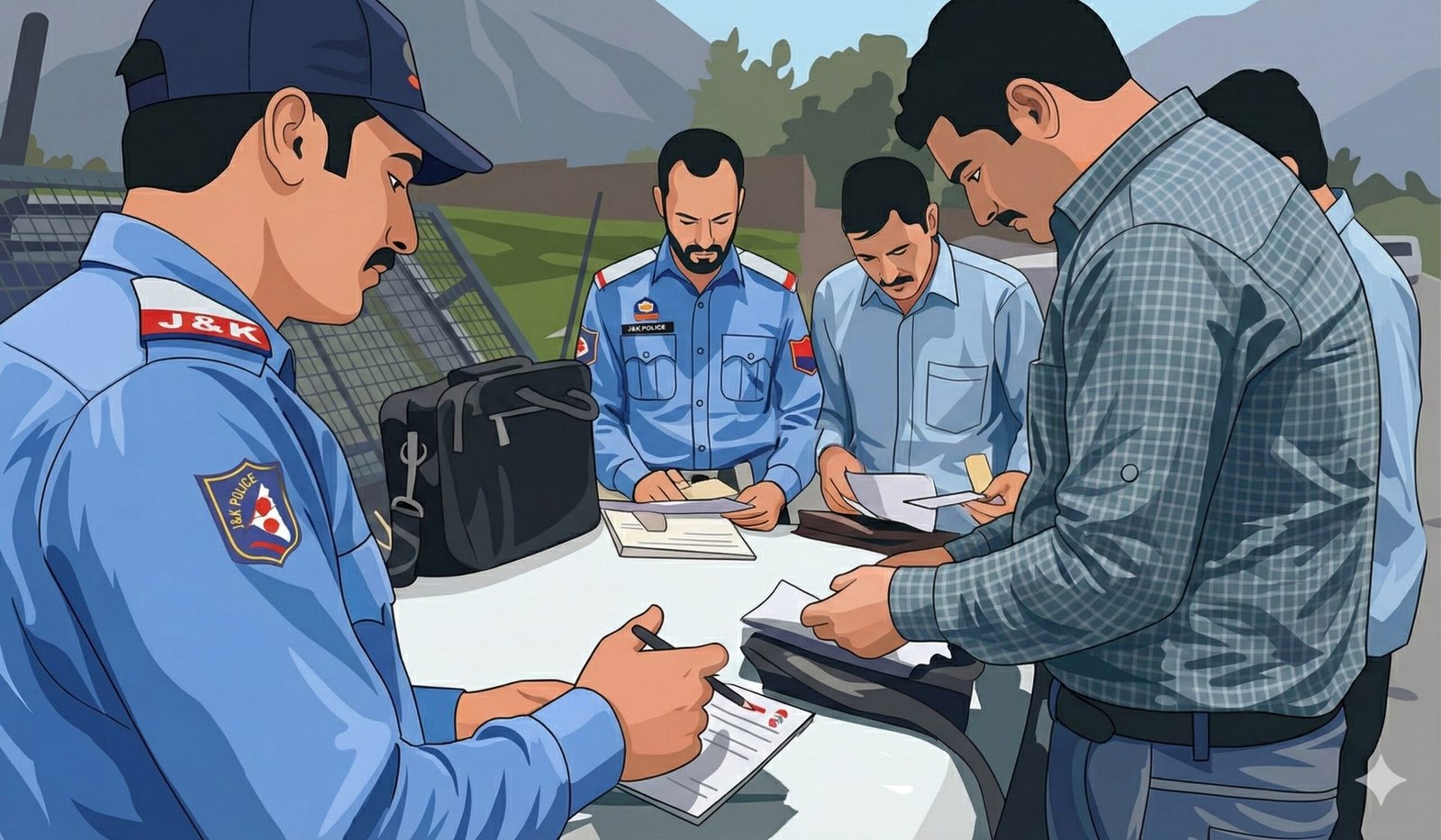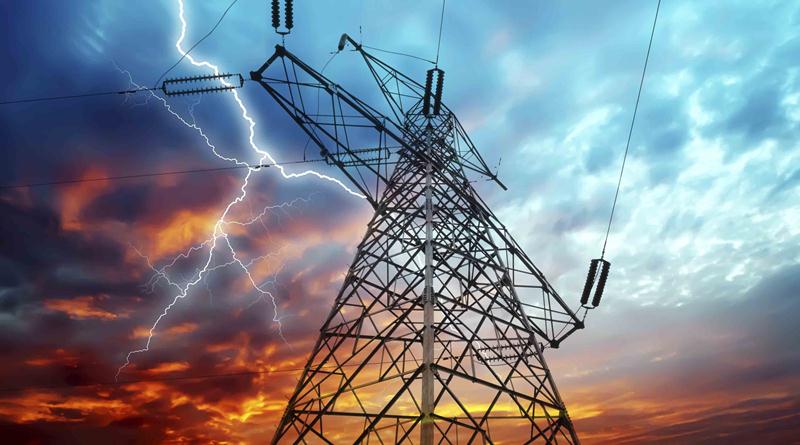Folk Dances of Jammu & Kashmir are an integral part of the cultural heritage of the Jammu and Kashmir Division. Get details of the Folk Dances of Jammu & Kashmir and their importance in maintaining the tradition.
Jammu and Kashmir is a land of rich diverse culture celebrating the differences in a unique sense of harmony and brotherhood. The two regions of Jammu and Kashmir- Jammu & Kashmir are a unique example of unity in diversity.
In the two regions, people have different culture, languages, folklore, traditions, yet they are inseparable, united by their brotherhood and nationality. Similarly, the traditional folk dance of Jammu and Kashmir also varies from region to region.
What is Folk Dance?
Folk Dance is a traditional form of Dance unique to a particular region, performed by a particular section of the people showcasing the culture of that region.
When are the folk dances of Jammu and Kashmir Performed?
Primarily the folk dances of Jammu and Kashmir are performed on different occasions. Some are performed on Marriage celebrations, Harvest season, Birthdays, on religious fairs.
There are many famous folk dances of Jammu and Kashmir preserving the Culture of the region.
List of Folk Dances of Jammu and Kashmir:
- Kud Dance
- Rouf Dance
- Dumhal Dance
- Hafiza Dance
- Bhand Jashan
- Bhand Pather
- Bacha Nagma
- Jagarna
- Crow Dance
- Chowki Nach
- Lohri Chajja Dance
- Heeran Dance
- Gojri Dance
- Dogri Dance
- Thali Dance
1. About Kud Dance
Kud is one of the most famous Dogra folk dance of Jammu and Kashmir which is surviving till date performed in honour of the ‘Kul Devta‘ in the Himalayan Mountains of the Jammu region.
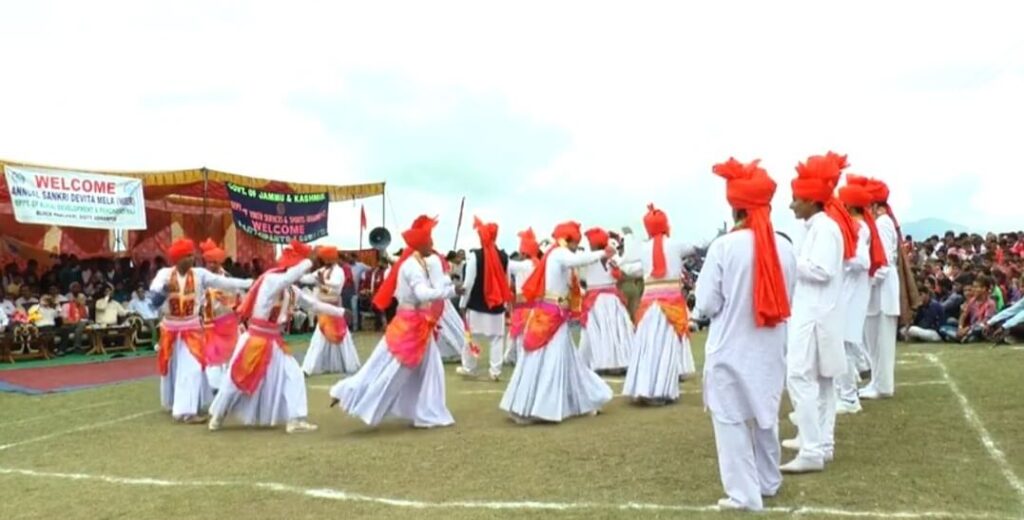
Kul Devtas are the Gods of local folklore and fables. They are often referred to as the Gramindevtas– the Gods of the village. Every clan or tribe of the village has its own Kuldevta. However, all the Devtas are pious to all the people.
Some famous Kuldevi & Kuldevtas are- Bawe wali Mata, Baba Sidhgoria Nath, Baba Birfa Nath, Baba Vasuki Nag, etc.
Read also: Dogra Traditional Dress for Men and Women
When Kud Dance is performed?
Kud Dance is performed to show gratitude towards the Kul Devta after a good harvest and for saving their crops and lives from natural calamities.
Moreover, it is also performed on special occasions and events. Kud is one of the most famous Jammu dance forms.
How Kud Dance is Performed?
Kud Dance is performed in Kurtas, Chudidar bottoms & Turbans by men whereas women wear Dogri Suit while performing Kud Dance.
Various music instruments- Narsingha, Drums, flutes etc are used while performing the Kud Dance.
Kud is performed with various delicate and articulate steps pleasing to the mind. Kud is often performed encircling the bonfire.
2. All about Rouf Dance
Rouf is a popular and main folk dance of Kashmir performed by women of the Kashmiri community. Rouf Dance is generally performed in the Kashmir valley.

Rouf is performed with the intriguing footwork carefully resonating with one another. The dance is performed on special occasions. Traditional Kashmiri Dress is worn while performing the rouf dance.
Rouf dance pronunciation- Rouf is pronounced as ‘Ruf‘ in Srinagar while in other parts of Kashmir, Rouf is pronounced as ‘Row‘.
When Rouf Dance is performed?
Rouf folk dance of Jammu and Kashmir is performed primarily on special occasions- Eid-ul-Fitr, on some Cultural events, Harvest Season and on other festive seasons.
Rouf dance is the most important and famous folk dance form of Kashmir Valley. The dance is initially associated with the harvest, however, at present, it has become the trademark dance of Jammu and Kashmir.
How Rouf Dance is performed?
The female performers lined up to form a human chain generally in two rows facing each other. Then on the beat of traditional Kashmiri Music, the performers matched the movements of their feet.
3. Dumhal Dance
Dumhal Dance of Jammu and Kashmir is another one of the most famous dance forms of Jammu and Kashmir. Dumhal folk dance form of Jammu and Kashmir is performed by the men of the Wattal Tribe.
When Dumhal Dance is performed?
Dumhal Dance of Jammu and Kashmir is performed to welcome the Spring season in Jammu and Kashmir. This dance form is unique to the Wattal Tribe of Jammu and Kashmir.
How Dumhal Dance is performed?
Dumhal Dance is performed on the beats of Drum and other instruments. They wear conical hats, colourful robes, beautiful ornaments while performing the Dumhal Dance of Jammu and Kashmir.
A Banner is dug into the ground before the dance. The men dance around the banner while singing in synchronised chorus.
Read also: Scriptural Virasat: Understanding Gurmukhi, Takri, Lande, and Dogra Akkhar Connections
4. Hafiza Dance
Hafiza Dance is a Kashmiri folk dance performed by the women of Kashmir, particularly in marriage ceremonies. Apart from weeding the dance form is also performed in festivals. Hafiza dance form is very popular in Kashmir.
The Dance and the music of Hafiza dance form have the influence of Persian literature & Sufi philosophy. Moreover, the dance is performed on the Sufiana Kalam Music (Devotional Sufi Music), the classical music of Kashmir.
However, this dance form is on the verge of extinction as there are not many artists who can perform the dance. We need to preserve this traditional dance form of Kashmir.
When Hafiza Dance is performed?
Hafiza folk dance of Jammu and Kashmir is performed mainly on the wedding ceremonies and festivals by Kashmiri women.
How Hafiza Dance is performed?
Hafiza is performed on the musical strings of Santoor. The dance is performed in a group, artists performed the intricate moves while singing the songs.
5.Bhand Jashan
Bhand Jashan is a traditional folk dance form of Kashmir. It is a mix of theatre and dance performed by a number of professional artists. Bhand Jashan is performed with light and soothing music in the background.
The dance is performed by a group of artists to raise the issues of social evils in society. Bhand Jashan is generally performed in the local squares and Chowks of the Kashmir region.
When Bhand Jashan is performed?
Bhand Jashan is performed in cultural events as well as in social gatherings for satire purpose. The Dance raises the local issues of the region in a humorous way.
How Bhand Jashan is performed?
Bhand Jashan is performed by artists belonging to a particular theatre group. In a group, there are generally 10-15 artists, dancers and musicians.
Bhand Jashan is performed with the costumes which can vary as per the act, while the music generally remains the same classical music of Kashmir.
6. Bhand Pather
Bhand Pather is the traditional folk theatre form of Kashmir practised in the Kashmiri community. This form of theatre is an age-old tradition of Kashmir surviving till date.
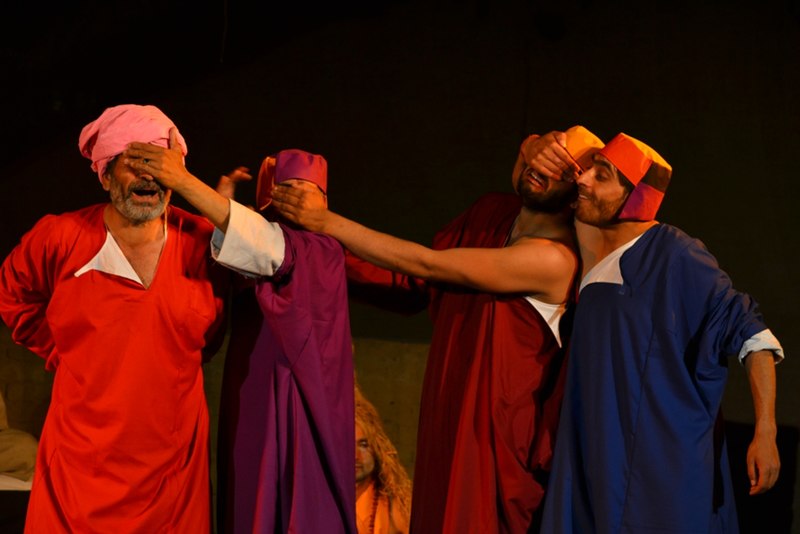
There are three main elements of Bhand Pather- Classic Instrumental Music, Dance & Acting.
In this folk dance of Jammu and Kashmir, Bhand Pather, the actors play different roles while raising the social, economical, political issue in order to aware the locals. Bhand Pather is generally practised in open spaces.
In the Bhand Pather, men play the role of women in the drama. Similarly, Muslims of the valley plays the role of Hindus as many plays revolve around the Hindu ritual and deities.
The means of conveying the message is convenient, satirical and humorous yet the impact it left on the mentality of the community is deep.
When Bhand Pather is performed?
Bhand Pather is performed in the social gathering, some theatre groups also perform in the marriage ceremonies.
How Bhand Pather is performed?
Bhand Pather is performed by the group of trained artists where skill has been passed from one generation to another- ‘Guru Shishya Parampara’
Bhand Pather is performed with the drums and Sitara in the background while the artists utter the dialogues related to the theme of the drama.
Read also: Things to know about Dogra Style Desi Chaa
7.Bacha Nagma
Bacha Nagma, often found its roots in Afghanistan, is one of the most popular dance forms of Jammu and Kashmir.
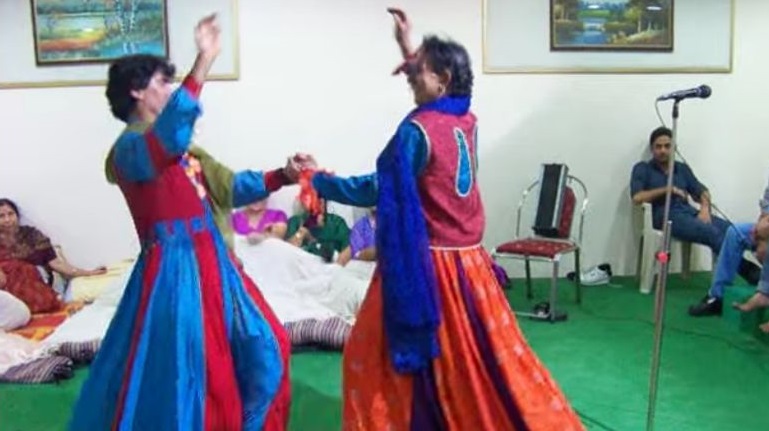
The dance is the derivate of the Hafiza dance. According to the folklore, the Maharaja of Jammu & Kashmir found Hafiza dance too intimate and immoral which is against the Sufi fundamentals so he banned Hafiza & introduced Bacha Nagma.
In Bacha Nagma Dance, teenage boys who are trained in Hafiza dance form dressed as women sing Kashmiri songs and dances on them. Bacha Nagma is a popular Kashmiri folk dance.
When Bacha Nagma is performed?
Bacha Nagma is performed on social gatherings, harvests, festivals, religious occasions, weddings, particularly when weedings are performed over a boat in the Jhelum river.
How Bacha Nagma is performed?
Bacha Nagma is generally performed by a teenage boy who is dressed as a woman to perform Hafiza dance form. Kashmiri ballads and Sufia Kalam music is sung by the artists in order to perform the dance form.
8. Jagarna
Jagarna is a folk dance form of Jammu region performed particularly on marriage ceremonies. Jagarna is performed only by the females of the bridegroom’s side.

Jagarna is performed when the Baarat has left the home for the bride. It is inauspicious to left the wedding home of the bridegroom empty and quiet so some of the females of the family stay there & at night they perform Jagarna.
When Jagarna Dance is performed?
Jagarna song is performed by the ladies of the bridegroom’s family on the wedding night. Jagarna is a popular folk dance of Jammu region.
How Jagarna Dance is performed?
Jagarna folk dance of Jammu and Kashmir can be performed by all the ladies in the Dogra community. The Jagarna dance do not have any specific dance steps, however, the dance is unique and performed on the beats of drums, spoon ticklings and Dogri songs sang by all the ladies.
Read also: Things to know about Safa or Turban : The Pride Of Dogra
9. Kauwa Dance
Crow Dance or Kauwa Dance is a dance performed by the trained artist of the Jammu region. It is mainly a form of Dogra dance performed in the hilly region of Jammu.
However, at present, this form of dance is a rarity and can be seen only in cultural events and programmes organised by the government. The dance is itself a delight to watch as it is funny and popular among children.
When Kauwa Dance is performed?
Crow Dance is performed in the festival seasons, cultural events. The famous folk dance of Jammu is also performed on birthday celebrations as children like this dance form very much.
How Kauwa Dance is performed?
Kauwa Dance is performed by a skilful artist who imitates Crow and dance with the skilful movements, gestures and expressions.
The artist dressed in black coloured traditional Dogra attire to perform the Crow dance.
10. Chowki Nach
Chowki Nach is a dance form related particularly to the Jammu region. It is performed to pay respect to the local folklore Devi-Devtas of Jammu and Kashmir.
Chowki Nach is however not a dance form but a religious ceremony that is performed on the beats of Drums and Kark in the background.
Everyone in the Jammu region is familiar with the Chowki Nach as the local population of the Jammu region is a keen believer of God and Chowki Nach is related to the local God and Goddesses.
When Chowki Nach is performed?
Chowki Nach is performed on religious ceremonies. Every year the Kuldavta Fair (Mel) is organised by the temple authorities, in the fairs Pilgrims perform the Chowki Nach.
How Chowki Nach is performed?
Chowki Nach is performed by a single person at a time, however, this is not a strict rule. In the Nach, the person uses Sacred Sangal to beat himself. It is believed that the Devta himself enters into the body of the person to perform Chowki Nach.
11. Lohri Chajja Dance
Lohri is a very famous festival of Jammu celebrated in almost every part of the Jammu region. In Lohri, people celebrate the festival by exchanging Dry fruits, Peanuts, Gajak and other similar stuff to relatives and neighbours.

Lohri ChajjaDance is performed by the children while asking for Lohri to neighbours. A Chajja is prepared prior to the Lohri festival.
When Chajja Dance is performed?
Chajja Dance is performed on the occasion of Lohri in the Jammu region while it is also performed on stage at Cultural events.
How Chajja Dance is performed?
Chajja folk dance of Jammu and Kashmir is performed by young boys while singing Dogri songs and poems.
One of the famous Dogri poems is:
Toda!
Tode upar saag.
Saag!
Saag wich mirch!
Mirch!
Mirch lgi kodi.
Kodi!
Deyo sanu lohri.
Toda!
Tode upar saag.
Saag!
Saag wich mirch!
Mirch!
Mirch lgi kodi.
Kodi!
Deyo sanu lohri.
12. Heeran Dance
Traditional Heeran Dance is also performed in Jammu on the Occasion of Lohri. Heeran Dance whose literal meaning is Deer Dance.
Dogri Traditional music and songs are also performed on Heeran dance and at night a bonfire is lit and Arg is given to the fire God.
When Heeran Dance is performed?
Heeran dance is performed on Lohri celebrations. On Lohri, while Chajja dance is performed by the young boys, Heeran dance is performed by the adults.
How Heeran Dance is performed?
Heeran Dance is performed by the Dogras of the Jammu region dressed as a Heeran and dances on the beat of Drums, Nagara and flutes.
Read also: Dals and Dogras – A weekly menu of a typical Dogra household
13. Gojri Dance
Gojri Dance is a dance performed by the Gujjar Tribe of Jammu and Kashmir. The Gujjar community is a nomadic tribe residing in the mountains of Jammu and Kashmir.
The Gujjar Dance is performed by the male and females of the Gujjar Tribe. The Gujjars have their own distinctive language, dress and Music.
When Gojri Dance is performed?
Gojri Dance is performed on wedding occasions by the Gujjar community. It is also performed to express happiness in the community.
How Gojri Dance is performed?
Gojri Dance is performed with the Gojri music while wearing the Gojri traditional dress- headgear, Kurta Pyjama for men & Salwar Kameez for the females.
14. Dogri Dance
Dogra is an ethnic tribe from the mountains and plains of the Jammu region. The traditional Dance of Dogra is known as Dogri Dance. The Dance is performed on the beat of Dholak and Chimta.
The Dance is performed on the Pakh Music which is a unique style of singing a song. Pakhs are very popular in the Jammu region. Pakhs are mainly sung in Dogri Language. Moreover, Dogri Dance is performed over Pakhs.
When Dogri Dance is Performed?
Dogri Dance is performed in functions or events. It is also performed in social gatherings and annual Shinj which is a popular wrestling event in the Jammu region.
How Dogri Dance is Performed?
Dogri Dance is performed by a group of Artists. The main leader sings the song as well as dances while the others are in the sitting position provide beats of Drums and Chimta.
15. Thali Dance
Thali Dance was popular among people of Ramban in Jammu & Kashmi. In old times Thali Dance used to perform it during Kirtan or Jagrans to appease local deities.

Accordingly, a function was held at night wherein large number of people was invited to sing religious songs during the night followed by Arti or Bhog to the local deities in the morning. During Arti one of the persons danced while keeping Thali (plate) filled with sweets in his palm. At present, one can still witnesses this tradition in some rural societies.
When Thali Dance is Performed?
As per another folk tale, It was the time when hilly people of Ramban had no source of amusement. In weddings, Thali dance was played by groom after sitting on the shoulders of Mama (maternal uncle) with Thali in palm on concluding day of the ceremony. Usually along with Sehra (wedding accessory) some money was also kept in the plate. This tradition was attributed to successful completion of marriage ceremonies.
How Thali Dance is Performed?
The uniqueness of Thali Dance comes with the beautiful customary dogra dress with colourful Safa (Turban). Traditional Murli (Flute) and Dholki (drum) are played together on the sound of Shiney (two flat plates). During dance Narsingha is also blown loudly. The music team comprising two flute players, Dholki master and his associates perform sitting while as dancers after making entry in a row with two steel plates on their palms move in a circle very aesthetically. Many swinging and skilful movements with the plates are made. The dance begins in slow beat followed by rapid and complex steps. Eventually, one of the artists also wears a colourful Ghagra (traditional skirt) which moves beautifully with every movement of the dancer .Sometimes over plates, glass filled with water or katori (bowl) are also placed in order to attract the audience.
Read also: Dogra Traditional Dress for Men and Women
The folk dances of Jammu & Kashmir showcase the rich cultural heritage and traditions of the region. From the lively and vibrant Rouf Dance to the graceful Jagarna Dance, these dances reflect the joys, sorrows, and daily lives of the people. With rhythmic movements, colorful costumes, and rhythmic beats, these dances evoke a sense of unity and celebration. Preserving the essence of the past while embracing the modern era, Jammu & Kashmir’s folk dances continue to captivate and enthrall audiences, serving as a vibrant reminder of the Jammu & Kashmir’s cultural diversity and artistic excellence.



